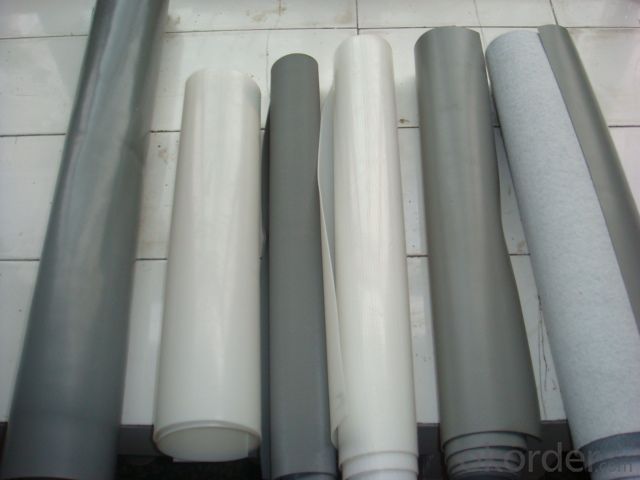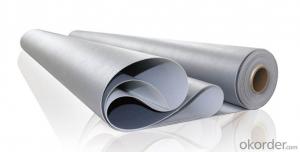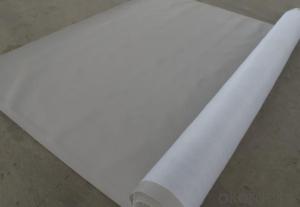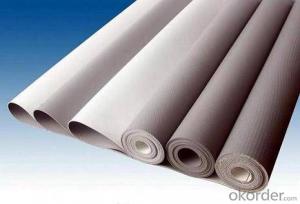Basement PVC Waterproofing Membrane without Compound Layer
- Loading Port:
- China main port
- Payment Terms:
- TT OR LC
- Min Order Qty:
- 5000 m²
- Supply Capability:
- 100000 m²/month
OKorder Service Pledge
OKorder Financial Service
You Might Also Like
Introduction
Polyvinyl Chloride (PVC) waterproof membrane is a new polymer waterproof membrane which is made from polyvinyl chloride resin, and mixed with plasticizer, filler, antioxygen, ultraviolet absorber and other auxiliaries.
Features
1. Good combination of high elasticity and tensile strength.
2. Fine resistance to static electricity.
3. Excellent resistance to ageing / weathering.
4. Durable, the effective age can be more than 20 years used on exposed surfaces, used on non-exposed surfaces, it can reach 50 years.
5. Fine flexibility at low temperature, adaptable to cold conditions.
6. Root-resistance can be used on the planting roofs.
7. Fine puncture resistance, joint peel strength and joint shear strength.
8. Fine UV-resistance, no pollution to environment.
9. Easily welding, installing, secure.
10. Easy treatments to the delicate parts of corners and edges.
11. Convenient maintenance with low cost.
Specification
No. | Item | L | N | W | ||||
I | II | I | II | I | II | |||
1 | Tensile strength N/cm ≥ | 100 | 160 | 8 | 12 | 100 | 160 | |
2 | fracture elongation %≥ | 150 | 200 | 200 | 200 | 150 | 200 | |
3 | Dimension Changing at heating %≤ | 1.5 | 1 | 3 | 2 | 1.5 | 1 | |
4 | Foldability at low temperature °C | -20 | -25 | -20 | -25 | -20 | -25 | |
5 | Water tightness | No leakage | No leakage | No Leakage | ||||
6 | Joint shear resistance (N/mm)≥ | 3 | 3 | 6 | ||||
7 | Thermal Ageing treatment | Appearance | no bubble | no bubble | no bubble | |||
Tensile strength changing rate % | ±25 | ±20 | ±25 | ±20 | ±25 | ±20 | ||
Breaking elongation changing rate% | ||||||||
8 | Chemical corrosion resistance | foldability at low temperature °C | -15 | -20 | -15 | -20 | -15 | -20 |
Tensile strength changing rate % | ±25 | ±20 | ±25 | ±20 | ±25 | ±20 | ||
Breaking elongation changing rate% | ||||||||
9 | Artificial climate accelerated aging | foldability at low temperature °C | -15 | -20 | -15 | -20 | -15 | -25 |
Tensile strength changing rate % | ±25 | ±20 | ±25 | ±20 | ±25 | ±20 | ||
Breaking elongation changing rate% | ||||||||
RFQ
1. What is your MOQ?
--Our MOQ is 5000 m2
2. Can you provide sample?
--Yes, samples are in stock. we can offer free sample for you.
3. Do you offer OEM service?
--Yes, we can print customers’ logo on the packaging;
And the size and specification can be produced and design according to your demand.

- Q:Can a waterproofing membrane be applied in cold weather conditions?
- Yes, a waterproofing membrane can be applied in cold weather conditions. However, it is important to note that the specific temperature range in which it can be applied may vary depending on the product and manufacturer guidelines. Some waterproofing membranes are designed to withstand cold temperatures and can be applied as low as -20 degrees Celsius (-4 degrees Fahrenheit), while others may have a higher minimum application temperature. It is crucial to follow the instructions provided by the manufacturer and ensure that the surface is properly prepared and free from any ice, snow, or moisture. Additionally, it is recommended to consult with a professional contractor who has experience working with waterproofing membranes in cold weather conditions to ensure the best results.
- Q:Can a waterproofing membrane be used in hot climates?
- Certainly, hot climates are indeed suitable for the utilization of a waterproofing membrane. In fact, it is imperative to employ a waterproofing membrane in regions characterized by elevated temperatures and strong sunlight. The purpose of this membrane is to safeguard against water infiltration, which is of utmost importance in order to avert any harm to structures such as roofs, balconies, or basements. Furthermore, a top-notch waterproofing membrane is specifically engineered to endure the impacts of temperature fluctuations and UV radiation, guaranteeing its long-lastingness and efficacy even amidst scorching climates. Consequently, it is highly recommended to employ a waterproofing membrane in hot climates to ensure the resilience and integrity of the structures to which it is applied.
- Q:Can a waterproofing membrane be used for bridges or parking decks?
- Yes, a waterproofing membrane can be used for bridges or parking decks. Waterproofing membranes are commonly used in these structures to protect them from water damage and extend their lifespan by preventing water infiltration and corrosion. The membrane acts as a barrier, preventing water from seeping into the structure and causing structural deterioration or compromising the integrity of the bridge or parking deck.
- Q:Is a waterproofing membrane resistant to extreme weather conditions?
- Yes, a waterproofing membrane is designed to be resistant to extreme weather conditions. It provides a protective barrier against heavy rain, snow, and intense sunlight, ensuring that it remains intact and effective in preventing water infiltration and damage to the underlying structure.
- Q:Does a waterproofing membrane prevent mold and mildew growth?
- Yes, a waterproofing membrane can help prevent mold and mildew growth by creating a barrier that prevents moisture from seeping into walls, floors, or other surfaces. By keeping the area dry, it reduces the conditions necessary for mold and mildew to thrive. However, it is important to note that a waterproofing membrane alone may not completely eliminate mold and mildew, as proper ventilation and maintenance are also crucial in preventing their growth.
- Q:Does a waterproofing membrane require any specific preparation of the substrate before installation?
- Yes, a waterproofing membrane typically requires specific preparation of the substrate before installation. The substrate needs to be clean, dry, and free from any debris, oils, or contaminants that may hinder adhesion. It may also require smoothing or leveling of the surface to ensure proper application and effectiveness of the membrane.
- Q:Can a waterproofing membrane be used in new construction?
- Yes, a waterproofing membrane can be used in new construction. In fact, it is often recommended to install a waterproofing membrane during the construction phase to prevent water damage to the building's foundation and structure.
- Q:What is BSB waterproofing membrane
- SBS waterproofing membrane is: The thermoplastic elastomer is used as a modifier to make impregnated and coated materials, and the upper surface is covered with a polyethylene film, fine sand, mineral sheet (granule) or aluminum foil, copper foil and other insulating material made of curled sheet waterproof materials. Styrene-Butadiene-Styrene means: styrene-butadiene-styrene. SBS rubber modified petroleum asphalt for the invasion of the cover layer to polyester fiber non-woven fabrics, jute cloth, fiberglass mats were made for the fetal base, the plastic film for the anti-sticking isolation layer, the selection, ingredients, eutectic , Invasion, composite molding, curling and other processes processing production.
- Q:Does a waterproofing membrane require a primer before application?
- Yes, a waterproofing membrane typically requires a primer before application. A primer helps to enhance the adhesion of the membrane to the substrate and ensures a proper bond between the two. It also helps to seal the surface, preventing any moisture or contaminants from compromising the effectiveness of the waterproofing system. Using a primer before applying the waterproofing membrane is important for achieving a durable and long-lasting waterproofing solution.
- Q:Are waterproofing membranes suitable for balconies and terraces?
- Yes, waterproofing membranes are suitable for balconies and terraces. These membranes are specifically designed to provide a protective barrier against water and moisture, preventing any potential damage to the structure of the balcony or terrace. Waterproofing membranes are typically made of materials such as rubber, bitumen, or PVC, which are highly resistant to water penetration. They are applied as a liquid, sheet, or spray, creating a seamless layer that covers the entire surface of the balcony or terrace. This ensures that no water can seep through and cause any structural issues, such as cracks, leaks, or deterioration. Additionally, waterproofing membranes can also protect against other forms of damage, such as mold growth or corrosion. Overall, using waterproofing membranes on balconies and terraces is an effective and recommended solution for maintaining their longevity and structural integrity.
1. Manufacturer Overview |
|
|---|---|
| Location | |
| Year Established | |
| Annual Output Value | |
| Main Markets | |
| Company Certifications | |
2. Manufacturer Certificates |
|
|---|---|
| a) Certification Name | |
| Range | |
| Reference | |
| Validity Period | |
3. Manufacturer Capability |
|
|---|---|
| a)Trade Capacity | |
| Nearest Port | |
| Export Percentage | |
| No.of Employees in Trade Department | |
| Language Spoken: | |
| b)Factory Information | |
| Factory Size: | |
| No. of Production Lines | |
| Contract Manufacturing | |
| Product Price Range | |
Send your message to us
Basement PVC Waterproofing Membrane without Compound Layer
- Loading Port:
- China main port
- Payment Terms:
- TT OR LC
- Min Order Qty:
- 5000 m²
- Supply Capability:
- 100000 m²/month
OKorder Service Pledge
OKorder Financial Service
Similar products
New products
Hot products
Hot Searches
Related keywords




























